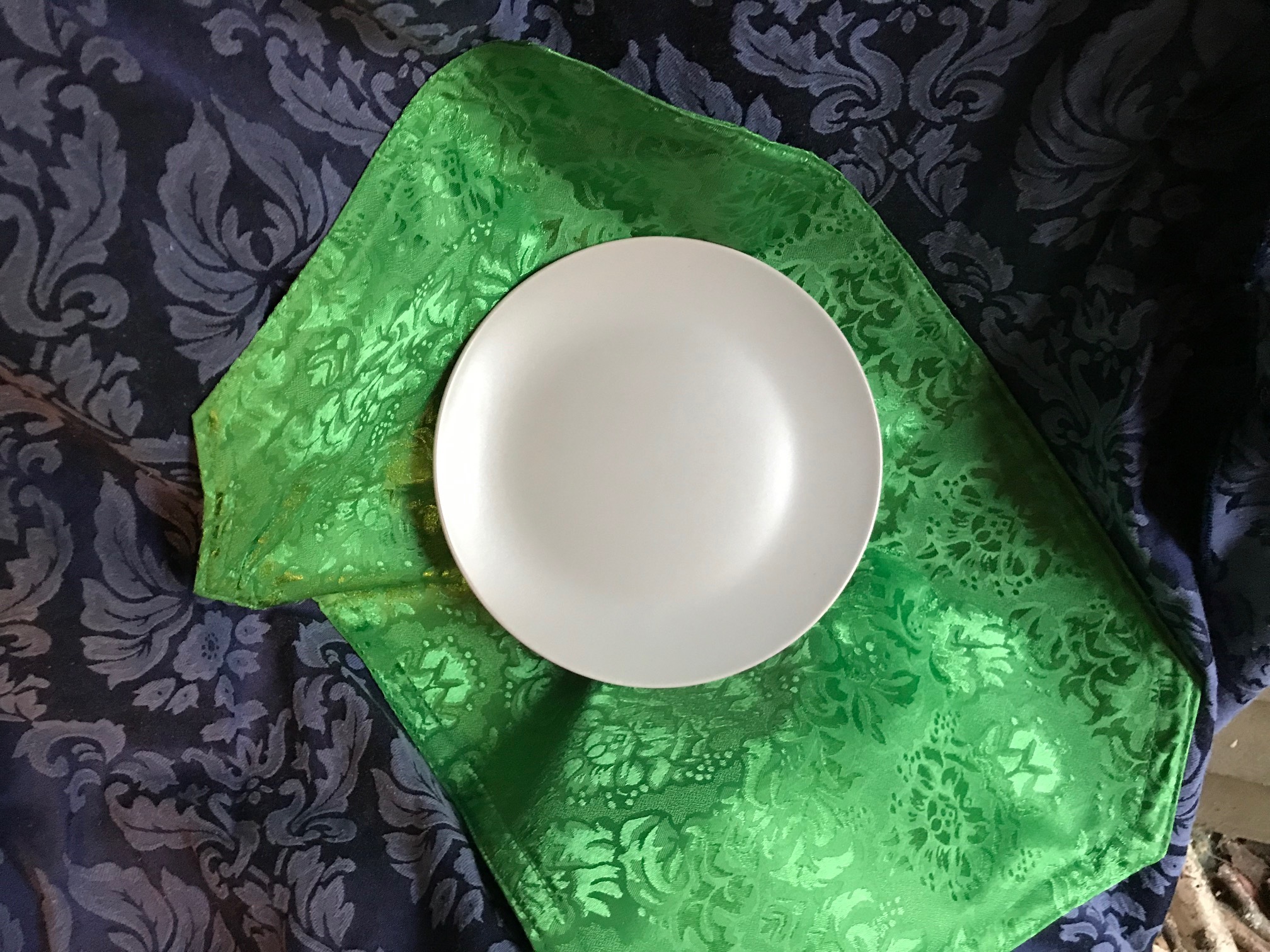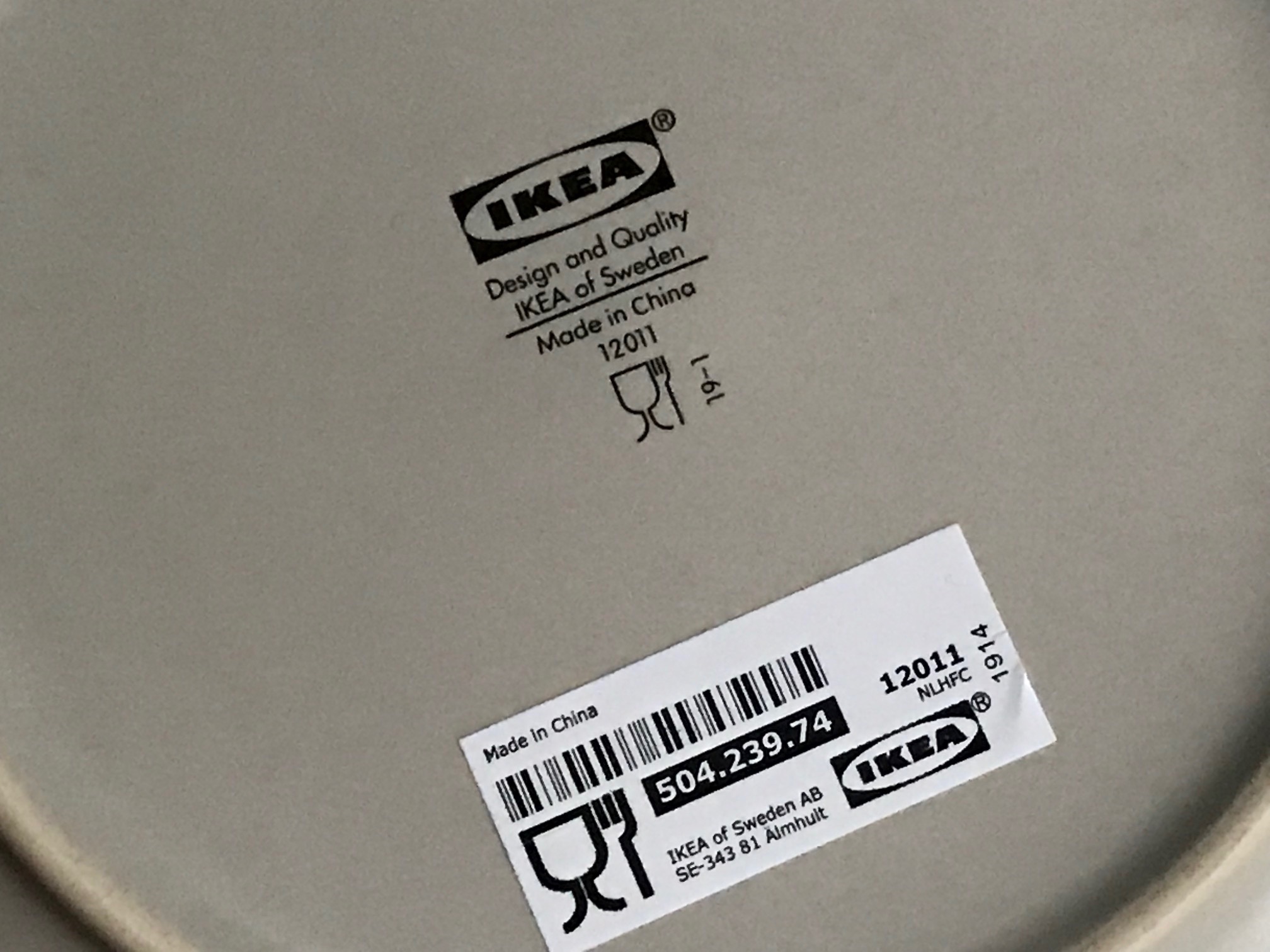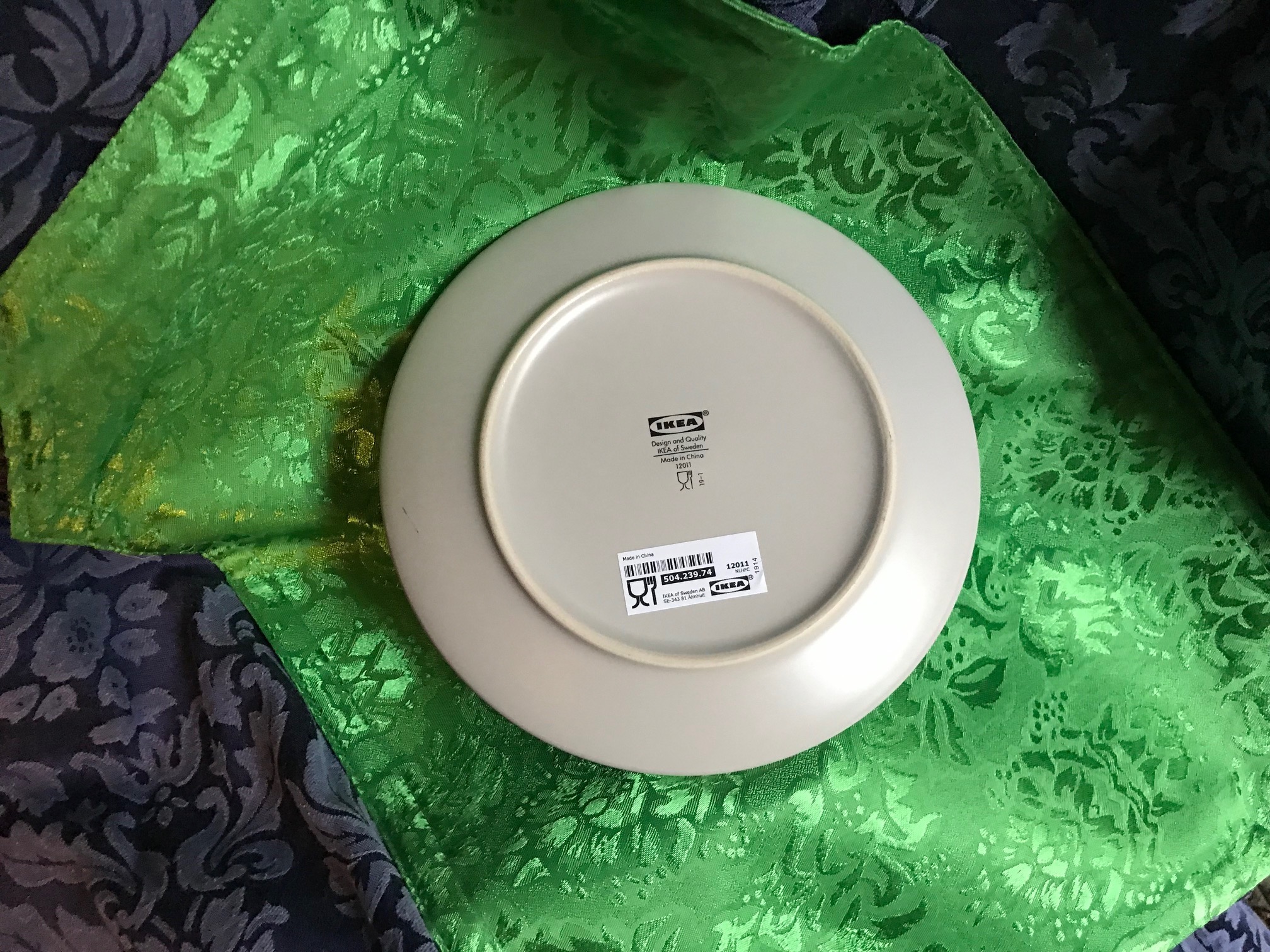2019 Ikea Brand, Made In China – Dinera matte beige dish: 52 ppm Lead. (Read full post for details.)
Background on my work testing Ikea products since 2009:
Since I get so many *Ikea* questions (and since I have long-recommended Ikea as a great general-purpose go-to brand), I decided to purchase some new, current Ikea plates myself, and post their test results here on the blog. With much of what I test and report on here on the blog being used items sent in by my readers, I don’t always know the date of manufacture, or the date of purchase – and often I also don’t know the manufacturer’s exact model number or color name (or pattern name). By purchasing some of these Ikea offerings brand-new at the store myself (in September of 2019), I can give my readers a definite picture of Ikea’s current offerings, and confirm whether or not they have Lead [and if they do, what the levels are].
In the past 10 years, Ikea has generally been a safe choice.
If you have been following my work for much of the 10+ years I have been doing (and reporting on) consumer goods testing (using XRF technology), you have probably read some or all of the following statements typed by my fingers:
- Nearly all Ikea products I have tested in the past 10 years have been either Lead-free or Lead-safe.
- By “Lead-safe” what I mean is that any Lead detected is within a “safe range” by the current best (European and U.S.) standards.
- Safe range is determined both by the level of Lead detected (taking into account the margin of error of detection) and the intended use of the product.
- NOTE: Prior to 2010 there are definitely examples of high-Lead Ikea items; please click this link to see one of those.
Overall, what were the results of the testing of new (2019) Ikea products?
Over the next day or two I will be posting more than 10 new (September, 2019 purchased) examples of Ikea products, with their XRF test results. While several of these examples are completely Lead-free, I want to mention (in this summary that I am including with each one of these posts) that some of these items have tested positive for a low-level of Lead [a level that is a fraction of what I find in most older dishes – but still slightly higher than what I would strictly consider to be in the “unquestionably Lead-safe” range]. As a result of these new findings, I intend to make periodic trips to Ikea to purchase more new examples and colors of their products so consumers can have a better sense of which NEW Ikea items are definitely either completely Lead-free, or Lead-safe.
Additionally, with each of these posts – as the items have been purchased new – I will be including photos of the back side of the item with the store label with the identifying model number and other relevant information, so my readers can make choices for their homes based on that information.
Important to note:
While some of these products may be positive for trace levels of Lead with XRF testing, I am confident (given Ikea’s use of European manufacturing standards) that they pass any relevant leach testing standards for toxicants at the time of manufacture. As always, my concern for Lead content in dishware is not for what happens when they are new – but what may happen in the long term, with years (or even decades) of regular use — daily use, as intended for food use purposes – including with hot and acidic foods – like coffee, lemonade, salad dressing and tomato sauce, and machine dishwashing, chipping and wear (or breakage), etc. over the years.
What are the exact XRF test results for the dish pictured in this post?
Food surface of the plate (180-second test):
- Lead (Pb): Negative / Non-Detect
- Cadmium (Cd): Negative / Non-Detect
- Mercury (Hg): Negative / Non-Detect
- Arsenic (As): Negative / Non-Detect
- Antimony (Sb): Negative / Non-Detect
- Barium (Ba): 510 +/- 52 ppm
- Zinc (Zn): 20,100 +/- 400 ppm
- Copper (Cu): 433 +/- 43 pm
- Nickel (Ni): 142 +/- 52 ppm
- Iron (Fe): 1,579 +/- 143
- Vanadium (V): 622 +/- 38 ppm
- Titanium (Ti): 1,282 +/- 65 ppm
- Zirconium (Zr): 19,100 +/- 400 ppm
- Platinum (Pt): 225 +/- 74 ppm
- Cobalt (Co): 276 +/- 66 ppm
Glazed area on back side of the plate (60-second test):
– around logo area
- Lead (Pb): 28 +/- 14 ppm
- Cadmium (Cd): Negative / Non-Detect
- Mercury (Hg): Negative / Non-Detect
- Arsenic (As): Negative / Non-Detect
- Antimony (Sb): Negative / Non-Detect
- Barium (Ba): 865 +/- 67 ppm
- Zinc (Zn): 12,000 +/- 300 ppm
- Copper (Cu): 453 +/- 51 pm
- Iron (Fe): 1,481 +/- 169 ppm
- Vanadium (V): 1,185 +/- 63 ppm
- Titanium (Ti): 2,431 +/- 115 ppm
- Zirconium (Zr): 20,500 +/- 500 ppm
- Platinum (Pt): 273 +/- 75 ppm
- Cobalt (Co): 286 +/- 79 ppm
Unglazed rim on the backside of the plate (60-second test):
- Lead (Pb): 52 +/- 16 ppm
- Cadmium (Cd): Negative / Non-Detect
- Mercury (Hg): Negative / Non-Detect
- Arsenic (As): Negative / Non-Detect
- Antimony (Sb): Negative / Non-Detect
- Barium (Ba): 212 +/- 55 ppm
- Zinc (Zn): 4,034 +/- 165 ppm
- Copper (Cu): 260 +/- 49 pm
- Iron (Fe): 3,967 +/- 298 ppm
- Bismuth (Bi): 129 +/- 20 ppm
- Vanadium (V): 503 +/- 48 ppm
- Titanium (Ti): 1,407 +/- 97 ppm
- Zirconium (Zr): 6,492 +/- 179 ppm
- Platinum (Pt): 151 +/- 62 ppm
All [2019] tests reported on my blog are done for a minimum of 60 seconds per test (unless otherwise noted), using a freshly-calibrated XRF instrument, testing in “Consumer Goods” mode. Testing is always repeated in each instance to confirm the results. Results are science-based, accurate (within the margin of error noted), and replicable. Metals not listed were not detected by the XRF in Consumer Goods mode.
Conclusion:
I would consider this dish to be in the “Lead-safe” range. As the food surface was negative (non-detect) for Lead and the unglazed substrate (the rim) was positive for Lead, it appears that the glaze on this piece is Lead-free, and that the positive reading around the logo area is the XRF instrument reading through a thinner patch of Lead-free glaze to the Leaded substrate below. Of course without digestive sampling of both the substrate and the surface glaze this is just an educated guess (based on 10+ years experience doing XRF testing! 😉 )
As a matter of principal, I would personally not select these particular dishes for my home, but if you served me food on them when I was visiting your house, I would not be at all concerned (especially if they were new and did not show any wear.) Again, the concern with any amount of Lead in dishware is what could potentially happen over the long-term, from heavy use, wear and abuse/mishaps, etc. You can read more about that on this post – link. It is my personal opinion and stand (more based on ethics and politics than based on the small amount of Lead in any one dish at these levels) that there should be no Lead at all in any dishware, which is why I choose to use undecorated, plain white glass (or clear glass) dishes in my home.
To see the dishes I use every day with my family, click here.
Overall, I still consider Ikea a great brand — however, I stick by my general philosophy when it comes to dishware that I feel confident to have kids eating off of daily: dishes should be simple and plain, decorated only with the food you serve on them – not with glazes, paints or other decorative coatings. That is your best bet, across the board.
I am not particularly enthusiastic about (the quality or durability of) Ikea furniture, but their stainless pots and pans tend to be low-nickel (which is a good thing and preferred by many consumers), and their ceramics and glassware still skew to mostly being Lead-safe or Lead-free (with exceptions like this one, where the consumer really has no way of knowing the difference between this and others.)
To see more Ikea products I have tested, click here.
As always, thank you for reading and for sharing my posts.
Please let me know if you have any questions.
If you appreciate the work I do (especially the consumer goods test results that I report here on this blog), please consider making a small contribution to help cover the costs of these types of (unfunded / unsponsored) posts. Here’s the “Chip-In” link with a bunch of different ways to contribute. Here’s a post with all the different ways you can hire me (an even better way to help support what I do!)
Tamara Rubin
#LeadSafeMama
Ikea glazed ceramic plate model: 504.239.74
12011 • Made in China

Never Miss an Important Article Again!
Join our Email List






Tamara, thank you for all the knowledge you share with us. I see IKEA has a beautiful white dinnerware, UPPLAGA. Have you tested any of those pieces? Thanks!
Thank you Tamara for your your work. I’ve bought IKEA dishes recently based on their claims to be “lead free” but have seen others Falsely claim the same. Have you or would you consider testing the ikea 365+ plates? The item number is 802.589.44
If you haven’t I’d be happy to send you one for testing. Please just let me know how to get it to you. Again, thanks for educating us on keeping our families lead free.
Thank you for all your work and advocacy to educate. I appreciate that you are testing new IKEA dishes. Would you consider testing the Gladelig dishes. The bowl item number is 904.571.65? Thank you.
Did anyone ever find out any the Gladelig dishes? Are the ones plain glass dishes safe?
Hi. I do not see a follow up post to this, showing us the more recent ikea items that were tested. So anxious to find a set of modern white dishes that are safe and not Corelle. Thank you!